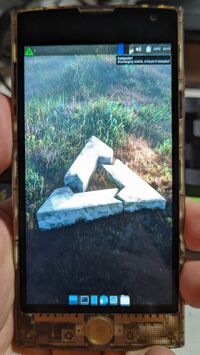LG Fx0 (lg-madai)
| This device runs a Downstream kernel. Some UIs will not work, and most features (3D acceleration, audio, etc.) may be broken. |
 LG Fx0 running Xfce4 | |
| Manufacturer | LG |
|---|---|
| Name | Fx0 |
| Codename | lg-madai |
| Model | LGL25 |
| Released | 2014 |
| Type | handset |
| Hardware | |
| Chipset | Qualcomm Snapdragon 400 (MSM8926) |
| CPU | 4x ARM Cortex-A7 |
| GPU | Adreno 305 |
| Display | 720x1280 TFT |
| Storage | 16 GB |
| Memory | 1.5 GB |
| Architecture | armv7 |
| Software | |
Original software The software and version the device was shipped with. |
Firefox OS 2.0 |
Extended version The most recent supported version from the manufacturer. |
Firefox OS |
| FOSS bootloader | no |
| postmarketOS | |
| Category | downstream |
Mainline Instead of a Linux kernel fork, it is possible to run (Close to) Mainline. |
no |
pmOS kernel The kernel version that runs on the device's port. |
3.4.0 |
Unixbench score Unixbench Whetstone/Dhrystone score. See Unixbench. |
890.1 |
| Device package |
|
| Kernel package |
|
Flashing Whether it is possible to flash the device with pmbootstrap flasher. |
Works
|
|---|---|
USB Networking After connecting the device with USB to your PC, you can connect to it via telnet (initramfs) or SSH (booted system). |
Works
|
Internal storage eMMC, SD cards, UFS... |
Untested
|
SD card Also includes other external storage cards. |
Untested
|
Battery Whether charging and battery level reporting work. |
Works
|
Screen Whether the display works; ideally with sleep mode and brightness control. |
Works
|
Touchscreen |
Works
|
| Multimedia | |
3D Acceleration |
Untested
|
Audio Audio playback, microphone, headset and buttons. |
Untested
|
Camera |
Untested
|
Camera Flash |
Untested
|
| Connectivity | |
WiFi |
Partial
|
Bluetooth |
Untested
|
GPS |
Untested
|
NFC Near Field Communication |
Untested
|
| Modem | |
Calls |
Untested
|
SMS |
Untested
|
Mobile data |
Untested
|
| Miscellaneous | |
FDE Full disk encryption and unlocking with unl0kr. |
Untested
|
USB OTG USB On-The-Go or USB-C Role switching. |
Untested
|
| Sensors | |
Accelerometer Handles automatic screen rotation in many interfaces. |
Untested
|
Magnetometer Sensor to measure the Earth's magnetism |
Untested
|
Ambient Light Measures the light level; used for automatic screen dimming in many interfaces. |
Untested
|
Proximity |
Untested
|
Hall Effect Measures magnetic fields; usually used as a flip cover sensor |
Untested
|
Haptics |
Untested
|
Barometer Sensor to measure air pressure |
Untested
|
LG Fx0, also known as LGL25, is a smartphone manufactured by LG Electronics. Fx0 was originally available only in Japan, sold by KDDI. The hardware is similar to LG G2 mini (lg-g2m) while Firefox OS is pre-installed instead of Android.
There are two known versions of Fx0. The original, SIM-locked and non-rooted version was available from the official sales channel. Later, the SIM-free and rooted version appeared in aftermarket. The rooted (SIM-free) version is strongly recommended if you try postmarketOS on Fx0.
Contributors
- peremen
- MasanoriOgino
Users owning this device
- MasanoriOgino (Notes: 2x)
- Peremen
How to enter flash mode
| The LG download mode is disabled by default. See the Installation section below for enabling it. |
To enter the LG download mode, unplug the device from the USB, power off, and hold while connecting to the USB [1]. You will see the DOWNLOAD MODE line if succeeded.
If lk2nd is installed, hold while booting to enter fastboot mode. Note that you can enter the LG download mode even if lk2nd is installed.
Installation
You need to erase the LAF partition to enable the LG download mode. Given that there is no KDZ or TOT file for this device available, it does not make sense to keep the LAF partition for flashing.
To backup the LAF partition, you need a working su on the device. On adb shell:
$ su
# dd if=/dev/block/platform/msm_sdcc.1/by-name/laf of=/sdcard/laf.img
# dd if=/dev/zero of=/dev/block/platform/msm_sdcc.1/by-name/laf
Then, on the host:
$ adb pull /sdcard/laf.img
Now, you can enter the LG download mode. While it provides some fastboot commands, it is unstable and lacks important features. lk2nd provides a more stable and full-fledged fastboot implementation. Download lk2nd-msm8226.img from the latest release of lk2nd.
We recommend to backup the boot partition before installing lk2nd.
$ # On adb shell:
$ su
# dd if=/dev/block/platform/msm_sdcc.1/by-name/boot of=/sdcard/boot.img
$ # On the host:
$ adb pull /sdcard/boot.img
Then, enter the LG download mode and flash lk2nd.
$ fastboot flash boot lk2nd-msm8226.img
$ fastboot reboot
You should backup the system and userdata partitions, at least.
$ fastboot fetch system system.img
$ fastboot fetch userdata userdata.img
Read and follow the general installation guide to continue installation.
Components
- UART: According to service manual UART is provided as a part of JTAG connector, unpopulated by default and only accessible after opening the case. The Pin 14 (lower right, bigger pad than others) is MSM_UART_TX, which needs to be hooked up to the RX of the UART adapter.
- Wi-Fi: Qualcomm WCNSS. Note that the LG source code archive lacks the prima driver, which is used in Firefox OS. According to
dmesgin Firefox OS, it is version v3.2.3.172. Porting the prima driver from LineageOS kernel makes Wi-Fi work, but it seems that NetworkManager seems not like this configuration. - Display: no backlight adjustment yet, also had to change the visual to RGB565 to get a working Xfce4.
- Given the sorry quality and lower version of stock LG kernel, maybe mainlining could be worth?
See also
- Kernel source (mirrored from LG OSS Center when it was alive)